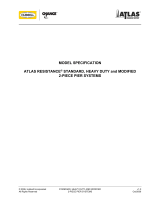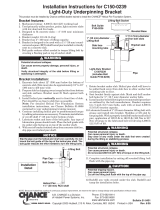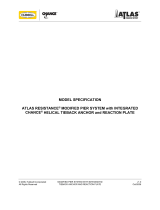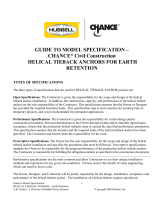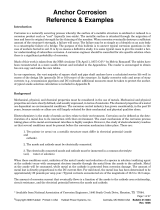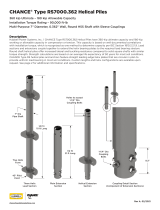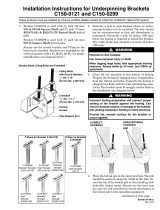Page is loading ...

Phone: 573-682-8414
Fax: 573-682-8660
www.abchance.com
Operating Instructions
2,500 ft-lb (3,390 Nm)
Hydraulic Helical Pier Installer Assembly
1. Two 12 ft (3.6 m) hoses
(Chance E303-0876 consists of 2)
2. 2,500 ft-lb (3,390 Nm)
Hydraulic Helical Pier Installer C303-1180
3. Yoke Assembly — E303-0680
▲
! WARNING
Read and Understand this instruction sheet
completely before installing a helical pier. These
instructions are intended to illustrate the use of
Hydraulic Helical Pier Installer Assembly. Helical
pier installing tools covered in this instruction
sheet must be used by competent personnel
familiar with and following good work and safety
practices. Should additional information and
details be desired, or if specific situations arise
which are not covered adequately herein, the
user should contact a Chance representative or
telephone Chance at 573-682-8414.
C303-1032 consists of the 6 items pictured below.
Two 16" (0.4m) hoses
E308-0578
Bent Arm Pin
P303-1221
Yoke
E303-0680
Bent Arm Pin P303-1219
Coil Lock P303-1215
Drive Tool
Coil Lock
P303-1215
Attach yoke to driver with
3/4" x 2-1/2" (19 mm x 63.5 mm)
long Grade 5
hex-head bolt
C303-1180
clockwise
counter-
clockwise
5. Hydraulic Control Valve C303-1031
© Copyright 2005 Hubbell, 210 N. Allen, Centralia, MO 65240 Printed in USA
NOTE: Because Hubbell has a policy of continuous product improvement, we reserve the right to change design and specications without notice.
These instructions do not claim to cover all details or variations in equipment, nor to provide for all possible conditions to be met
with concerning installation, operation, or maintenance of this equipment. If further information is desired or if particular problems
are encountered which are not sufficiently covered in this guide, contact Chance.
6. Square torque bar assembly - E303-1041
4. Two 25 ft (7.6 m) hoses
(each a Chance C417-6121)
P303-1094
Rev. D
C303-1032
Apply down pressure to the helical pier installer
to start the helical pier into the ground. Guide
the helical pier installer for correct placement
of the helical pier. Installation of a helical pier
in obstruction laden soils may move the helical
pier and installer head laterally and/or cause
the torque bar to disengage its restraint. The
restraining object must be able to resist the
torque and restrain the bar from disengage-
ment.
10. Helical pier advancement into the soil will
cause the installer to move downward. Once
the helical pier installer becomes level with
the resisting end of the torque bar as shown
in Figure 1, add helical pier extensions to the
helical pier. Don’t allow the installer end of
the torque bar to go below the resisting end
or the torque bar may move and break free of
the torque restraint.
NOTE: The gage on the hydraulic control valve
can be used to determine the torque output
of the helical pier installer. Maximum torque
is 2,500 ft-lb (3,390 Nm) at 1,550 psi (10,687
kPa).
For repairs or service, consult Chance.
11. To retrieve a helical pier, first move the torque
bar so that it will restrain a clockwise rotation
as shown in Figure 3 (counterclockwise, as
shown in Figure 2, for left hand helices).
12. After moving the torque bar, activate the
hydraulic control valve for counterclockwise
(clockwise for left-hand helices) rotation.
▲
! WARNING
High-powered, hand-held machinery.
Can cause property damage, severe injury, or death.
Do not torque above 2,500 ft-lb (3,390 Nm). Over-
torquing will damage the helical pier installer and can
lead to personal injury or death.
Hydraulic power source (not included)
2,500 psi (17,237 kPa) max and 8 gpm (30 L/min.)
Suggested power source -
CHANCE® hydraulic power unit C303-1201
Calibration Data
for C303-1032
Hydraulic Helical Pier Installer
Torque
ft-lb (Nm)
500 (677)
1,000 (1,356)
1,500 (2,024)
2,000 (2,711)
2,500 (3,390)
Hydraulic Control Valve
psi (kPa)
650 (4,481)
850 (5,860)
1,050 (7,239)
1,300 (8,963)
1,550 (10,687)
Torque bar
rotation (CW)
8 ft (2.4 m)
(minimum)
Keep all personnel
clear of shaded area
Retrieving a Helical Pier with
Right-Handed Helices (Standard)
View From Above
Figure 3
solid
object
to
resist
torque
and
restrain
bar
Helical pier rotation (CCW)
▲
! WARNING
Crushing hazard.
Can cause property damage, severe injury or death.
Do not try to manually restrain torque bar.
Restrain torque bar against a solid object capable of
withstanding 1,000 lb (4.5 kN) lateral force, in such a
way that any movement of the torque bar under load
will not allow it to disengage (see Figure 2).
Do not stand or place any body parts between the
torque bar and the object restraining it. Keep all
personnel clear of shaded area shown in Figure 2.
Minimum length of torque bar is 8 ft (2.4 m). A shorter
length will not adequately restrain the torque.
A.B. CHANCE is a Division
of Hubbell Power Systems, Inc.
© Copyright 2005 Hubbell, 210 N. Allen, Centralia, MO 65240 Printed in USA
NOTE: Because Hubbell has a policy of continuous product improvement, we reserve the right to change design and specications without notice.
P303-1094
Rev. D
A.B. CHANCE is a Division
of Hubbell Power Systems, Inc.
Phone: 573-682-8414
Fax: 573-682-8660
www.abchance.com

Figure 1
➲
▲
! WARNING
Inadequate maintenance or improper use of this
machine may lead to unexpected failure.
Can cause property damage, severe injury, or death.
Frequently inspect tools, hardware and hydraulic
hoses for damage, correct quantity, correct type, and
proper torque. Replace as necessary with the same
grade, type and size as the originals.
▲
! WARNING
Torque bar
rotation (CCW)
Helical pier rotation (CW)
8 ft
(2.4 m)
minimum
Installing a Helical Pier with
Right-Handed Helices (Standard)
View From Above
Figure 2
High-powered, hand-held machinery.
Misuse can cause property damage, severe injury or
death.
Do not use this machine unless you have read and
understand all instructions and warnings in this
instruction sheet P303-1094 and have been trained in
the proper operation of this equipment.
▲
! WARNING
Assembling for Operation
1. Assemble the plastisol coated eye bolts into
the small holes in the yoke so that the eyebolts
are inside the u-shape area of the yoke.
2. Attach the yoke to helical pier installer using
two
3⁄4" (19 mm) spacers,
1⁄4" (6 mm) thick wash-
ers and
3⁄4" x 21⁄2" (19 mm x 63.5 mm) long grade
5 hex head bolts provided with the yoke. Place
the washers and spacers between the yoke and
helical pier installer. The yoke should pivot
after assembly, but rotation should be limited
by the eye bolts. To avoid a pinchpoint condi-
tion, adjust eyebolts if necessary so that the
yoke doesn't rotate more than 30 degrees below
horizontal and hit the helical pier installer.
NOTE: keep 3⁄4" (19 mm) hex head bolts tight.
3. Connect one end of each of the two 25 ft (7.6
m) long hoses to the hydraulic control valve
and the other end to a hydraulic power unit
or hydraulic power source as shown below in
Figure 1.
4. Connect one end of each of the two 12 ft (3.6
m) long hoses to the helical pier installer hoses
and opposite ends to the two male couplings
on the hydraulic control valve as shown below
in Figure 1. This connection controls the ro-
tational direction of the helical pier installer.
Connect the hoses so that the helical pier
installer rotates in the clockwise direction
when the operator steps on the outside edge of
the foot pedal on the hydraulic control valve.
Check for proper rotation each time the hoses
are connected and reverse the hose connection
at the helical pier installer if necessary. The
operator of the foot control must always
know which direction the torque bar will
rotate before stepping on the foot control
to ensure safe operation.
5. Insert the helical pier shaft into the drive tool
on the helical pier installer and lock in place
using the bent arm pin and coil lock provided.
Check for three warning labels on both sides
of the torque bar and one on the helical pier
Crushing hazard.
Can cause property damage, severe injury or death.
Do not try to manually restrain torque bar.
Restrain torque bar against a solid object capable of
withstanding 1,000 lb (4.5 kN) lateral force, in such a
way that any movement of the torque bar under load
will not allow it to disengage (see Figure 2).
Do not stand or place any body parts between the
torque bar and the object restraining it. Keep all
personnel clear of shaded area shown in Figure 2.
Minimum length of torque bar is 8 ft (2.4 m). A shorter
length will not adequately restrain the torque.
8. The helical pier is now ready to install.
9. Activate the hydraulic control valve for a clock-
wise rotation (counterclockwise for left-hand
helices).
solid
object
to
resist
torque
and
restrain
bar
Keep all per-
sonnel clear
of shaded
area
installer for readability. Remove dirt, grime,
etc. or replace labels with Chance P303-1406,
P303-1473, P303-1474 and P303-1095 as nec-
essary.
6. Attach the torque bar to the yoke using the
bent arm pin; retain with the coil lock. The
condition of the torque bar is an important
factor affecting worker safety when install-
ing helical piers. At least weekly, check end
of the torque bar which goes into the yoke for
cracks, particularly in the corner areas. Any
cracking in the torque bar signals the end of
its useful life. Cracked torque bars must
be replaced. Use torque bar only with helical
pier installers capable of a maximum of 2,500
ft-lb (3,390 Nm).
7. Before installing an anchor in the clockwise
direction, position the torque bar as shown in
Figure 2. (NOTE: Helical piers
with left-hand helices will
require positioning of torque
bar per Figure 3 to install and
Figure 2 to retrieve.) The end
of the 8 ft (2.4 m). long torque
bar must be positioned against
a solid object capable of with-
standing 1,000 lb (4.5 kN) of
force in such a way that it will
not disengage the restraint
under load.
▲
! WARNING
Helical pier installation can puncture underground
utility service.
Can cause property damage, severe injury, or death.
Locate and avoid all underground-utility services
before installing a helical pier.
25-ft (7.6 m)
Hoses
Item #4
C417-6121
Helical Pier
Installer
Item #2
C303-1180
Eyebolts
Check bolts for
tightness daily
Attach torque bar with 3⁄4" x 5" (19 mm x 127 mm)
bent-arm pin and coil lock.
Yoke Assembly
Item #3
E303-0680
Hydraulic Control Valve
Item #5
C303-1031
To Hydraulic Power Source
Square Torque Bar
Item #6
E303-1041
12-ft (3.6 m)
Hoses
Item #1
E303-0876
Attach helical pier shaft to
the drive tool with 3⁄4" x 31⁄2"
(19 mm x 89 mm) bent-arm
pin and coil lock.
3⁄4" x 21⁄2" (19 mm x 63.5 mm)
Hex head bolts
WARNING
LABEL
WARNING
LABEL
WARNING
LABEL
P303-1406 P303-1474 P303-1473 P303-1095
WARNING
LABEL
Counter-
Clockwise Clockwise
/

